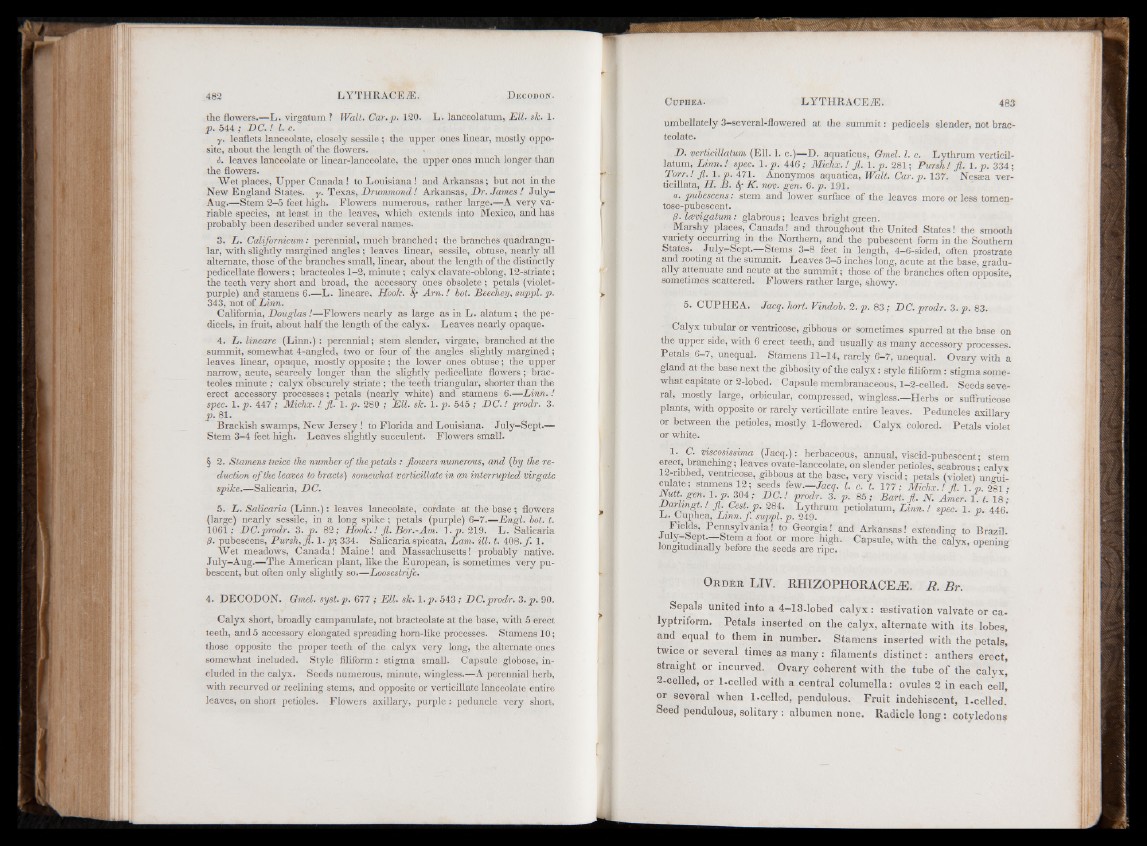
482 LYTHRACEÆ. D ecodon.
the flowers.—L. virgatum ? Walt. Car.p. 120. L. lanceolatum, Ell. sk. 1.
p . 544 ; EC. ! 1. c.
y. leaflets lanceolate, closely sessile ; the upper ones linear, mostly opposite,
about the length of the flowers.
<5. leaves lanceolate or linear-lanceolate, the upper ones much longer than
the flowers.
Wet places, Upper Canada ! to Louisiana ! and Arkansas; but not in the
New England States, y. Texas, Drummond! Arkansas, Dr. James ! July-
Aug.—Stem 2-5 feet high. Flowers numerous, rather large.—A very variable
species, at least in the leaves, which extends into Mexico, and has
probably been described under several names.
3. L. Califomicum: perennial, much branched; the branches quadrangular,
with slightly margined angles ; leaves linear, sessile, obtuse, nearly all
alternate, those of the branches small, linear, about the length of the distinctly
pedicellate flowers ; bracteoles 1-2, minute ; calyx clavate-oblong, 12-striate;
the teeth very short and broad, the accessory ones Obsolete ; petals (violet-
purple) and stamens 6.—L. lineare, Hook, q- A m .! hot. Beechey, suppl. p.
343, not of Linn.
California, Douglas !—Flowers nearly as large as in L. alatum ; the pedicels,
in fruit, about half the length of the calyx. Leaves nearly opaque.
4. L. lineare (Linn.) : perennial; stem slender, virgate, branched at the
summit, somewhat 4-angled, two or four of the angles slightly margined;
leaves linear, opaque, mostly opposite; the lower ones obtuse; the upper
narrow, acute, scarcely longer than the slightly pedicellate flowers; bracteoles
minute ; calyx obscurely striate ; the teeth triangular, shorter than the
erect accessory processes; petals (nearly white) and stamens 6.—Linn.!
spec. 1 .p . 447 ; Michx. ! f l . 1 .p. 280 ; Ell. sk. 1. p. 545 ; DC.! prodr. 3.
p . 81.
Brackish swamps, New Jersey ! to Florida and Louisiana. July-Sept.—
Stem 3-4 feet high. Leaves slightly succulent. Flowers small.
§ 2. Stamens twice the number of the petals : flowers numerous, and (by the reduction
of the leaves to bracts) somewhat verticillate in an interrupted virgate
spike.—Salicaria, DC.
5. L. Salicaria (Linn.): leaves lanceolate, cordate at the base; flowers
(large) nearly sessile, in a long spike ; petals (purple) 6-7.—Engl. bot. t.
1061; DC.prodr. 3. p. 82; Hook.! fl. Bor.-Am. 1 .p. 219. L. Salicaria
/?. pubescens, Pursh,fl. 1. p\ 334. Salicaria spieata, Lam. ill. t. 408. f . 1.
Wet meadows, Canada! Maine! and Massachusetts! probably native.
July-Aug.—The American plant, like the European, is sometimes very pubescent,
but often only slightly so.—Loosestrife.
4. DECODON. Gmel. syst.p. 677 ; Ell. sk. 1.p. 543; DC.prodr. 3. p. 90.
Calyx short, broadly campanulate, not bracteolate at the base, with 5 erect
teeth, and 5 accessory elongated spreading hom-like processes. Stamens 10;
those opposite the proper teeth of the calyx very long, the alternate ones
somewhat included. Style filiform: stigma small. Capsule globose, included
in the calyx. Seeds numerous, minute, wingless.—A perennial herb,
with recurved or reclining stems, and opposite or verticillate lanceolate entire
leaves, on short petioles. Flowers axillary, purple : peduncle very short,
umbellately 3-several-flowered at the summit: pedicels slender, not bracteolate.
D. verticillatum (Ell. 1. c.)—-D. aquaticus, Gmel. 1. c. Lythrum verticil-
latum, Linn.! spec. 1. p. 446; Michx'.! f l . 1. p. 281; Pursh! f l . 1 .p . 334;
Top-.! fl. 1. p. 471. Anonymos aquatica, Walt. Car.p. 137. Nessea ver-
ticillata, H. B. 8f K. nov. gen. 6. p. 191.
a. pubescens: stem and lower surface of the leaves more or less tomen-
tose-pubescent.
/?. leevigatum: glabrous; leaves bright green.
Marshy places, Canada! and throughout the United States! the smooth
variety occurring in the Northern, and the pubescent form in the Southern
States. ) July-Sept.—Stems 3—8 feet in length, 4—6-sided, often prostrate
and rooting at the summit. Leaves 3-5 inches long, acute at the base, gradually
attenuate and acute at the summit; those of the branches often opposite,
sometimes scattered. Flowers rather large, showy.
5. CUPHEA. Jacq. hort. Vindob. 2. p. 83; DC. prodr. 3. p. 83.
Calyx tubular or ventricose, gibbous or sometimes spurred at the base on
the upper side, with 6 erect teeth, and usually as many accessory processes.
Petals 6—7, unequal. Stamens 11—14, rarely 6-7, unequal. Ovary with a
gland at the base next the gibbosity of the calyx: style filiform: stigma somewhat
capitate or 2-lobed. Capsule membranaceous, 1-2-celled. Seeds several,
mostly large, orbicular, compressed, wingless.—Herbs or suflruticose
plants, with opposite or rarely verticillate entire leaves. Peduncles axillary
or between the petioles, mostly 1-flowered. Calyx colored. Petals violet
or white.
1. C. viscosissima (Jacq.): herbaceous, annual, viscid-pubescent; stem
fneCn . r f Chlng; leaves ovate-lanceolate, on slender petioles, scabrous; calyx
12-nbbed, ventricose, gibbous at the base, very viscid; petals (violet) unsrui-
culate; stamens 12; seeds few.—Jacq. 1. c. t. 177; Michx 'A 1 v 281 •
Nutt. gen.1 p . 304; DC.! prodr. 3. p. 85; Bart. fl. N. Am ’e r .l.'t. 18;
Darhngt.. fl. Cest.p. 284. Lythrum petiolatum, Linn.! spec. 1. p. 446.
Cuphea, Linn, f suppl. p. 249. r
Fields, Pennsylvania! to Georgia! and Arkansas! extending to Brazil.
July-Sept.—Stem a foot or more high. Capsule, with the calyx, opening
longitudinally before the seeds are ripe. J y °
O r d e r LIV. RHIZOPHORACEÆ. Ii. Br.
Sepals united into a 4-13-lobed calyx : aestivation valvate or ca-
lyptriform. Petals inserted on the calyx, alternate with its lobes,
and equal to them in number. Stamens inserted with the petals,
twice or several times as many : filaments distinct : anthers erect,
straight or incurved. Ovary coherent with the tube o f the calyx]
2-celled, or 1-celled with a central columella: ovules 2 in each cell,
or several when 1-celled, pendulous. Fruit indéhiscent, 1-celled.
Seed pendulous, solitary : albumen none. Radicle long : cotyledons